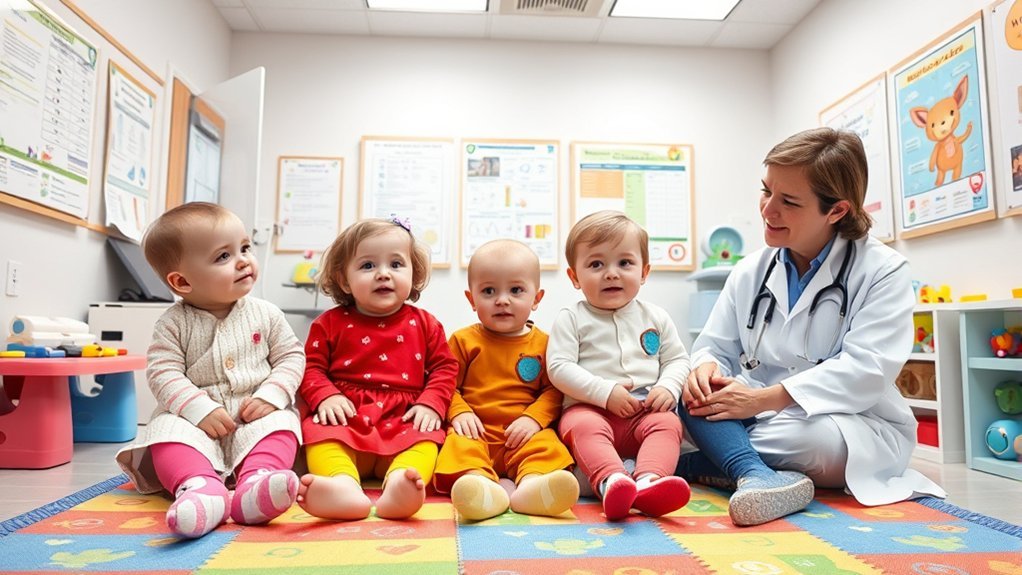Caring for twins can be both rewarding and challenging. Whether you have identical or fraternal twins, understanding their unique needs is essential. You might notice similarities in identical twins or distinct differences in fraternal ones, and both scenarios come with their own set of health concerns. Knowing when to seek medical advice can make a significant difference in their development. Let’s explore the key indicators that warrant a call to the doctor.
Understanding Identical Twins: Key Characteristics
When you think about identical twins, it’s fascinating to realize they share the same genetic makeup, which sets them apart from other sibling types. This genetic similarity means they often look strikingly alike, making it challenging for others to tell them apart. Identical twins originate from a single fertilized egg that splits into two embryos, leading to their uniform physical features and, in many cases, similar personalities. However, despite their similarities, individual experiences and environments can shape their unique traits. You might notice that they often develop their own identities over time. Identical twins also tend to share a deep emotional bond, understanding each other in ways that others may not. This connection can be both comforting and complex throughout their lives.
Exploring Fraternal Twins: Unique Traits
While identical twins share the same genetic code, fraternal twins offer a different perspective on sibling relationships. You’ll find that fraternal twins develop from two separate eggs fertilized by two different sperm cells. This means they can look quite distinct, often resembling regular siblings more than mirror images. Each twin has their own unique genetic makeup, leading to variations in traits such as hair color, eye color, and personality. You’ll also notice that fraternal twins might have different interests and hobbies, reflecting their individual identities. Despite these differences, they often share a close bond, traversing life together while maintaining their unique traits. Understanding these aspects can help you appreciate the diversity within sibling relationships among fraternal twins.
Common Health Concerns for Identical Twins
Although identical twins share the same genetic material, they can still face unique health concerns that warrant attention. Here are some common issues to watch for:
| Health Concern | Description |
|---|---|
| Genetic Disorders | Identical twins may have similar risks for inherited conditions. |
| Mental Health Issues | They can experience shared environmental stressors, leading to anxiety or depression. |
| Growth and Development | One twin may outgrow or develop differently, needing monitoring. |
| Autoimmune Diseases | Increased risk for conditions like lupus or thyroid disorders. |
| Cardiovascular Issues | Higher likelihood of similar heart-related health problems. |
Being aware of these concerns can help you seek medical advice when needed. Regular check-ups and open communication with healthcare providers are key to ensuring both twins stay healthy.
Health Issues Associated With Fraternal Twins
Identical twins face specific health concerns, but fraternal twins have their own set of challenges. One common issue is the risk of preterm birth. Fraternal twins often come from multiple pregnancies, which can increase complications. Additionally, you might notice a higher chance of gestational diabetes in mothers expecting fraternal twins.
Fraternal twins can also experience developmental delays or growth discrepancies, as they may not share the same environment or resources. Each twin’s genetic background is different, which can lead to varying susceptibility to health issues, such as allergies or asthma.
Monitoring their health closely is crucial, as fraternal twins may face these unique challenges, requiring tailored care and attention to guarantee both twins thrive together.
When to Seek Medical Advice for Twin Development
Knowing when to seek medical advice for your twins’ development is essential, especially since they may face unique challenges. Keep an eye on milestones and behaviors that could indicate potential concerns. If you notice any of the following signs, it’s time to consult a healthcare professional.
| Developmental Concern | Action Required |
|---|---|
| Delayed speech or communication | Schedule a speech evaluation |
| Significant weight differences | Consult a pediatrician |
| Poor coordination or motor skills | Seek an occupational therapist |
| Social withdrawal or behavioral issues | Talk to a child psychologist |
| Unusual repetitive behaviors | Discuss with a developmental specialist |
Being proactive can guarantee that your twins receive the support they need for healthy growth and development.
Frequently Asked Questions
Can Identical Twins Have Different Blood Types?
Imagine two trees sprouting from the same seed, yet each bears different fruits. Identical twins can have different blood types due to genetic variations, even though they share the same DNA. It’s a fascinating biological twist!
Do Fraternal Twins Share the Same Placenta?
Fraternal twins usually don’t share the same placenta. They develop from separate eggs fertilized by different sperm, resulting in two distinct placentas. However, in some cases, they might share one, but that’s rare.
How Do Genetics Affect Identical Twin Similarities?
Genetics plays a huge role in identical twins’ similarities, like in the case of the Jim twins, who shared strikingly similar habits and preferences despite being raised apart. Their shared DNA influences their physical traits and behaviors.
Are Identical Twins Always the Same Gender?
Yes, identical twins are always the same gender because they come from a single fertilized egg that splits. This genetic process guarantees they share the same sex, unlike fraternal twins who can be different genders.
Can Fraternal Twins Look Alike Despite Different Genetics?
Yes, fraternal twins can look alike despite their different genetics. They share about 50% of their DNA, which can lead to similar features, making it possible for them to resemble each other closely.
